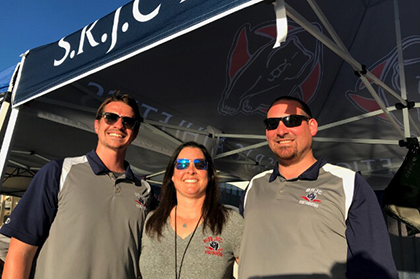‘He is meant to be alive’
THE DRAMATIC STORY OF HOW QUICK ACTION AND TRAINING SAVED THE LIFE OF A YOUNG SANTA ROSA MAN
Six coaches and swimmers from Santa Rosa Junior College have received the American Red Cross Certificate of Extraordinary Personal Action for their efforts to rescue a student athlete.
by Marcia Antipa

“The last thing I remember is looking up at the ceiling, and then I blacked out.”
On March 5, 2020, Santa Rosa Junior College (SRJC) student Morgan DeSalvo finished a lap of a swim team workout when a lifelong heart condition finally caught up with him.
Morgan and a few teammates were at the pool wall, catching their breath, when he slipped underwater and sank to the bottom. Swimmer Katie Morrison noticed Morgan underneath her.
“He [wasn’t] moving,” Katie recalls. “He was underwater on his back. His mouth and eyes were open.” She reached under Morgan’s arms and struggled to lift him. Teammate Megan Ference was in the next lane and hurried to help.
“I’m an open water lifeguard for the county, so I went into full emergency response,” Megan remembers. She dove underneath Morgan, pushed him up so that his face cleared the water, then screamed for Head Coach Jill McCormick.
The coaches all knew Morgan had a heart condition, though his doctors had cleared him to swim. “It was on his emergency card, says Jill. “So that made me go from, like, zero to 60 immediately.” She yelled for help from Assistant Coach Tyler Denize.

“Megan’s holding him up, his face is going in and out of the water,” says Denize. “So, I just grabbed his arms.”
As he pulled Morgan onto the pool deck, Megan ran to get Head Athletic Trainer Monica Ohkubo. “Megan comes flying in in her swimsuit, wet, and she looks like she’s seen a ghost,” Monica says. “And she’s like ‘we need you in the pool, now, AED – now!’”
As Monica raced to the pool, Coach Nolan Stimple ran in from the outdoor pool. He says, “Morgan looked grey, like concrete; his head was limp…his whole body was limp.”
Stimple, who had just recently completed an EMT training course, tried to find a pulse. “I flipped him on his back really quick and did it old-school style – [I] put my head on his chest.”
When Stimple still could not hear a heartbeat, he started CPR.
“Nolan was amazing because he just went to work,” says Coach Jill McCormick. “He was assessing him and immediately started CPR with no hesitation.”
McCormick grabbed the automated external defibrillator – or AED – that was mounted on the wall. She handed it off to Monica Ohkubo. Monica, a certified American Red Cross instructor, fought to get AEDs installed on campus. She followed the directions from the AED’s computer, attaching leads to Morgan’s chest.
“And there’s this long pause while the AED is analyzing the heart rhythm,” says Nolan, “I remember the pool deck just being so silent listening for this thing, and it said ‘shock advised.’”

“I’m shocking, shocking, shocking.” Monica Ohkubo remembers. “I hit the button, and his body jumps just like in the movies.”
Morgan was alive, thanks to CPR and the AED. But when the paramedics arrived, their own EKG showed an erratic heartbeat. So they rushed him to a local hospital. That night, Morgan was airlifted to UCSF in San Francisco’s Mission Bay, where he underwent open-heart surgery.
“I [received] a form of bio-prosthetic valve where they actually use my own pericardial tissue and stitched it in,” says Morgan. He may face further surgeries, but his coach says the new heart valve has made his recovery nothing short of amazing.
“He said he feels like a new man,” says Jill McCormick. “He went from like a Pinto engine to a Ferrari.”
Because of the coronavirus pandemic, the college suspended in-person classes and athletics. But Morgan takes part in team Zoom workouts, hiking, and running. He also is majoring in mathematics, has a 3.96 GPA, and hopes to attend the California Maritime Academy.
Looking back on that day when his coaches and teammates saved his life, Morgan says he is incredibly grateful. “Everyone worked flawlessly and perfectly as a team.”
Coach McCormick remembers, “There was no ‘what do we do now,’ no freak-out panic. That was due to training and experience.”
And Monica Ohkubo says “When you’re trained and your staff is trained, it should run like clockwork. It should be like a well-rehearsed dance.”
Coach Tyler Denize says he is grateful his training kicked in. “Talking to my wife that night, she said ‘I’m so sorry this day happened to you,’ and I was like ‘no, this was a fantastic day; a stressful day, but I’m going to sleep happy because he’s ok.’”
Fellow swimmer Megan Ference sums it up: “If it wasn’t for a lifeguard and an amazing crew right then and there – [I mean] for it all to happen and all of us there at that moment – he is meant to be here. He is meant to be alive.”
Get Trained
Red Cross training gives people the knowledge and skills to act in an emergency and save a life. A variety of online, blended (online and in-person skills session) and classroom courses are available at redcross.org/takeaclass.
Nominate Someone
People can go to LifesavingAwards.org to nominate and recognize an individual or group of individuals who have used the skills and knowledge learned in an American Red Cross Training Services course to help save or sustain a life.
Marcia Antipa is a volunteer writer with the Northern California Coastal Region.
